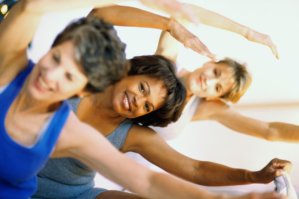Quick tips on diet and exercise
 When trying to lose weight, it is usually easier to achieve results if you change your diet. It is also important to exercise. Just remember that in order to burn the calories that you get from eating a single candy bar, you need to walk for an hour or more.
When trying to lose weight, it is usually easier to achieve results if you change your diet. It is also important to exercise. Just remember that in order to burn the calories that you get from eating a single candy bar, you need to walk for an hour or more.
General dietary advice
Choose good, fresh raw materials and prepare your meals from scratch
Carefully study the declaration with regard to expiry date, energy distribution, content of different sugars, fat, additives etc. Avoid industrially processed foods and stick with fresh raw materials, as they provide much more vitality.
Get plenty of protein with your meals
Protein is important for your muscle mass, blood sugar levels, metabolism, and nervous system. Good protein sources are lean meat, eggs, shellfish, legumes, and nuts. Animal protein sources are especially good for regulating your blood sugar and fat burning. Many people who hit the wall in the afternoon typically need more protein for lunch – for instance by eating 60-120 grams of meat, fish, or eggs.
Go with the coarse carbohydrates
Carbohydrate is an important source of energy, especially for the brain. You should go with the fiber-rich sources such as whole-grain, whole-grain pasta, and brown rice. Limit your intake of potatoes, regular pasta, and white rice. Avoid altogether or limit your intake of sugar and white bread.
Consume healthy fats and avoid the unhealthy ones
Fat is an important source of energy, especially for the muscles and the heart. Choose healthy, unspoiled sources like nuts, kernels, seeds, avocado, oily fish, olive oil, and rapeseed oil. Avoid margarine and industrially processed fats. For baking, you should use butter or virgin olive oil that can tolerate being heated
Eat fruit and vegetables every day
Preferably 400-600 grams (1-2 fruits and 3-5 vegetables). Limit your fruit intake when trying to lose weight. Link: Fructose – seducing and fattening
Drink plenty of water and be careful with liquid calories
Your daily need for liquids is 30 ml for every kilo of bodyweight (around two liters) – a little more if you sweat a lot or weigh more than 70 kilos.
Drink at least three glasses of regular tap water daily. You can also drink green tea, coffee, or herbal tea. Avoid liquid calories if you want to lose weight.
Diet plate model
When plating up your food, the right placing of the different food ingredients may help you obtain the optimal energy distribution and the right amounts of fiber, vitamins, and minerals.
Twenty-five % protein and fat – or more
Including lean meat, fish, shellfish, eggs, tofu, legumes, chickpeas (humus), nuts, kernels, seeds, avocado, olive, cold-pressed oils (olive, rapeseed, or coconut), oil and vinegar salad dressing and some good mayonnaise. Animal protein sources that contain a complete amino acid complex are often best when you are trying to lose weight. When eating vegetarian dishes, combine the protein sources so you are sure to include all the amino acids, and you often need more of these foods to help stabilize your blood sugar.
Twenty-five % carbohydrate – or less
Including brown rice, whole grains, oats, whole-grain pasta, millet, bulgur, Jerusalem artichoke, sweet potatoes, and quinoa (a gluten-free grain variety). Limit your intake of potatoes, normal pasta, and corn. Try to avoid sugar and white bread. Many people lose weight by excluding wheat (gluten) and potatoes from their diet. Notice that the number of overweight people is higher in countries where they eat a lot of pasta/white bread/potatoes, while there are more slender people in countries where rice is the preferred source of carbohydrate.
Fifty % fruit and greens – mostly vegetables
Including vegetables like broccoli, cauliflower and other types of cabbage, beans and legumes, carrots, beets and other root vegetables, sprouts, asparagus, tomato, bell pepper, radishes, lettuce, leeks, aubergine (eggplant), and different types of mushrooms. You may also include apples, pears, berries, pineapple and other fruits, but vegetables must play the dominant role.
Tip: Make it a habit only to take one serving. Chew your food slowly and enjoy it.
Cardiovascular fitness, metabolic fitness, and fast tips
You can increase your fat burning and build muscle mass with different forms of exercise. However, what is even more important is how you spend the 14-15 hours of the day where you are neither exercising nor sleeping. Studies show that when we are physically inactive for hours at a time, our metabolic rate drops and our risk of abdominal obesity increases. It is therefore highly important for you to strengthen both your cardiovascular fitness and metabolic fitness, something that many people neglect because they only engage in hardcore training and fitness (which they often end up dropping after some time).
You can improve your metabolic fitness with light physical activities that do not make you winded. This steps up the body’s fat burning, which requires a lot of oxygen. It is good to get up from your chair many times during the day and engage in all kinds of small activities – even those that last less than five minutes. Did you know that people who walk a lot are often slim? Use a pedometer or your smart phone to make sure that you walk more than 5,000 steps daily. Ten thousand is even better.
Your cardiovascular fitness improves when you get exhausted, so it is good for you to make your pulse go up every day. This strengthens your heart and muscle mass. When you are winded, your body primarily burns carbohydrates. Once your heart rate has gone down again, your metabolic fitness and fat burning increase for a while following the physical activity.
Choose a type of exercise that you will enjoy for a long time
It is a good idea to exercise with others because it makes you feel more motivated. For instance, if running or swimming alone tends to bore you, you are better off by choosing dancing, Zumba, a team sport, golf or something else that is more fun and includes being together with others. You should also aim for a sport or exercise type that you can enjoy all year round, and which is not too challenging for your weight and fitness level. Remember to take it easy in the beginning. Make realistic goals. What matters is that you get up from your chair and become active. Also, remember to walk as much as you possibly can – indoors and outdoors.
Avoid “hitting the wall” after your training
If you exercise without eating, your blood sugar will plummet, and that creates a craving for fast carbs. This will cause you to consume more calories than you have burnt. At the same time, the carbohydrates are stored four times faster after your training, which increases the risk of excess carbohydrates being converted into fat deposits. Therefore, never exercise on an empty stomach. Also, wait at least an hour after your training session before you eat more calories. That way, you burn your fat deposits, instead. If you feel you have “hit the wall” and have a strong craving for something sweet, choose a protein bar, a banana, or a cup of black coffee or tea.
- Created on .








 "After about one week of taking the Q10 supplement I could feel a huge difference," says 23-year old Alan Piccini, who has been suffering from extreme fatigue and muscle aches ever since he was a child.
"After about one week of taking the Q10 supplement I could feel a huge difference," says 23-year old Alan Piccini, who has been suffering from extreme fatigue and muscle aches ever since he was a child. “Taking capsules with co-enzyme Q10 has freed me of the severe side effects of my cholesterol lowering medicine,” Mrs Franken explains.
“Taking capsules with co-enzyme Q10 has freed me of the severe side effects of my cholesterol lowering medicine,” Mrs Franken explains.